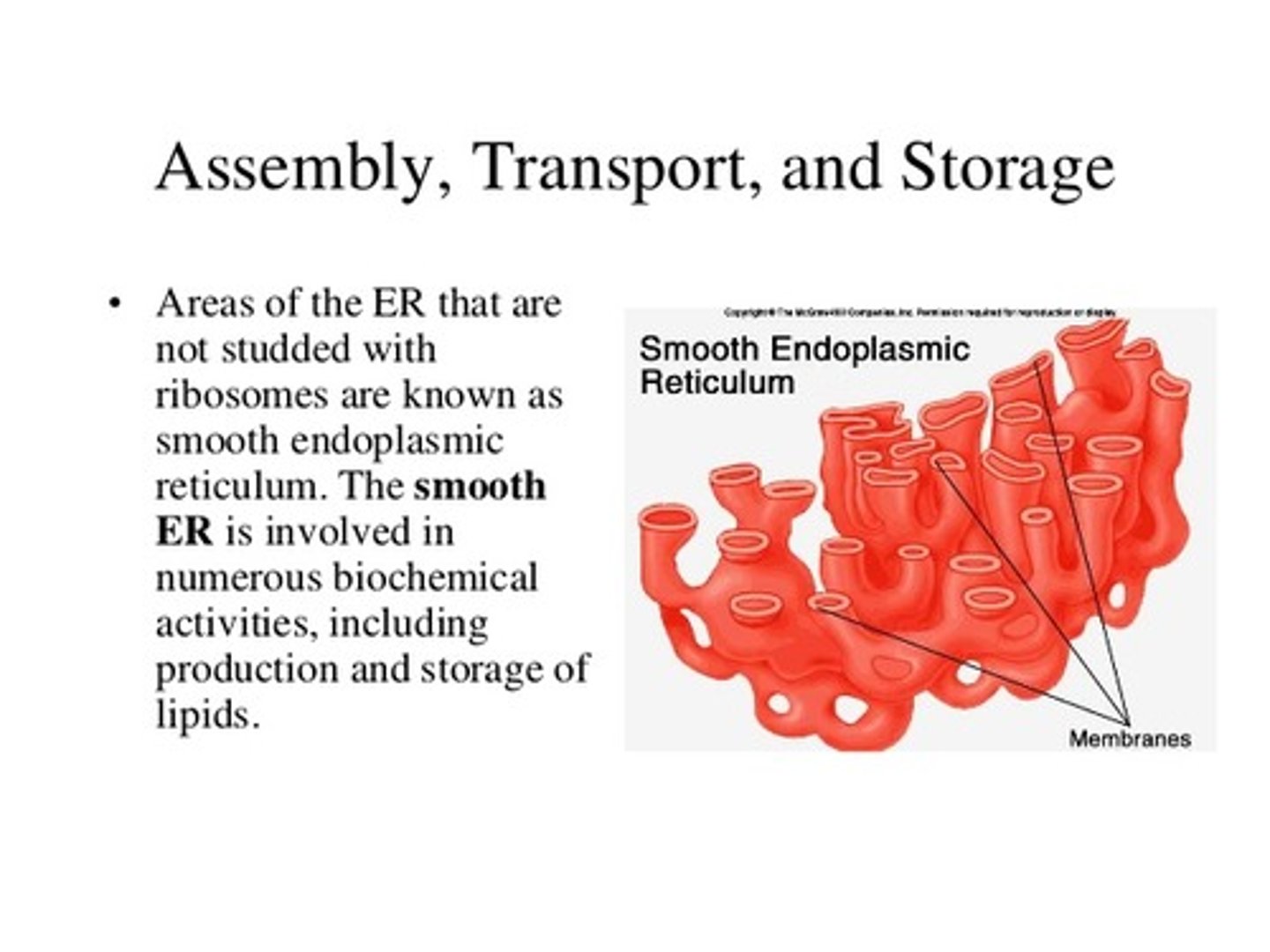Biochemistry II Lesson 3: Fatty Acid Synthesis
1/46
There's no tags or description
Looks like no tags are added yet.
Name | Mastery | Learn | Test | Matching | Spaced |
|---|
No study sessions yet.
47 Terms
Glycogen is stored in which of the following locations?
I. Liver
II. Pancreas
III. Muscles
(A) I Only
(B) II Only
(C) I and II Only
(D) I and III Only
(D) I and III Only
Glycogen is stored in the liver and the muscles.
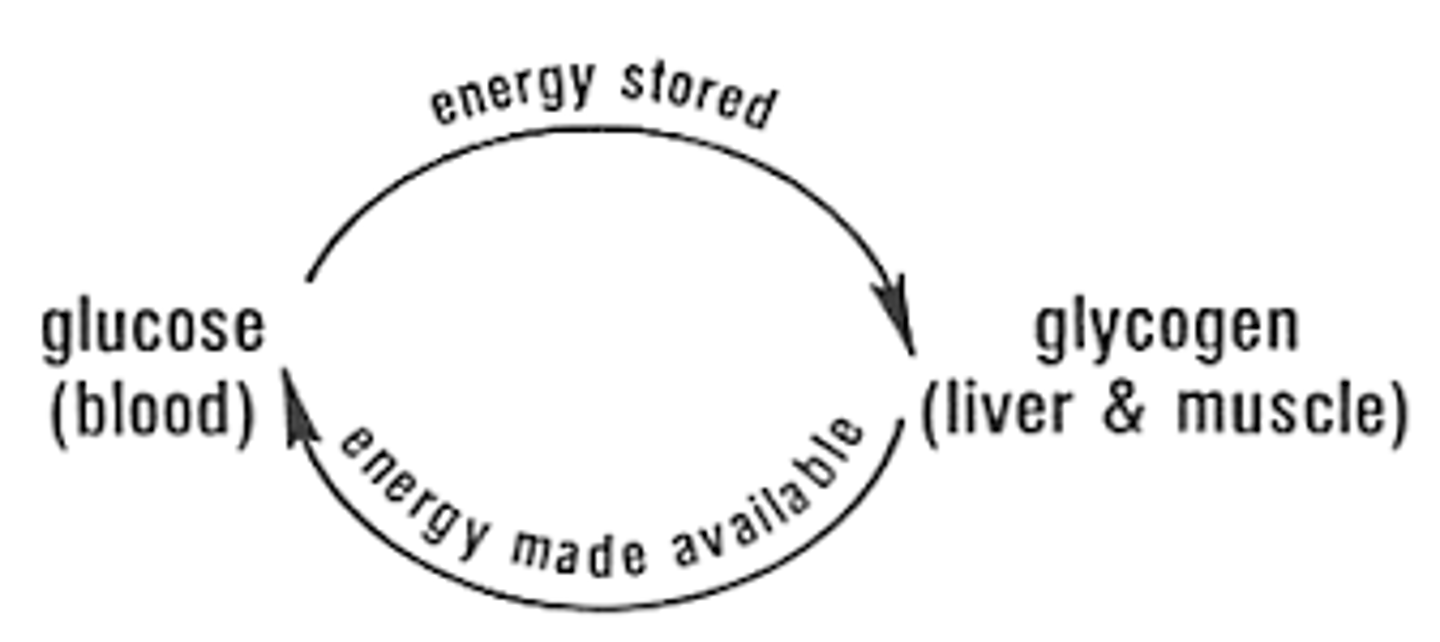
What is the kcal/g yield for each of the following stores of energy?
(1) Glycogen
(2) Protein
(3) Fat
(1) Glycogen - 4 kcal/g
(2) Protein - 4 kcal/g
(3) Fat - 9 kcal/g
A man's adipose tissue has a mass of 12,000 grams. If the man needs 2,000 kcal of energy per day, how many days will the man be able to survive on his fat stores?
(A) 13
(B) 24
(C) 37
(D) 54
(D) 54
12,000 grams x 9 kcal / gram = 108,000 kcals of total energy
108,000 kcals / 2,000 kcals = 54 days
The man would be able to survive for 54 days on just his fat stores alone!
Draw or visualize a triacylglyceride.
A triacylglyceride consists of three acyl groups bound to a glyceride molecule via ester bonds.
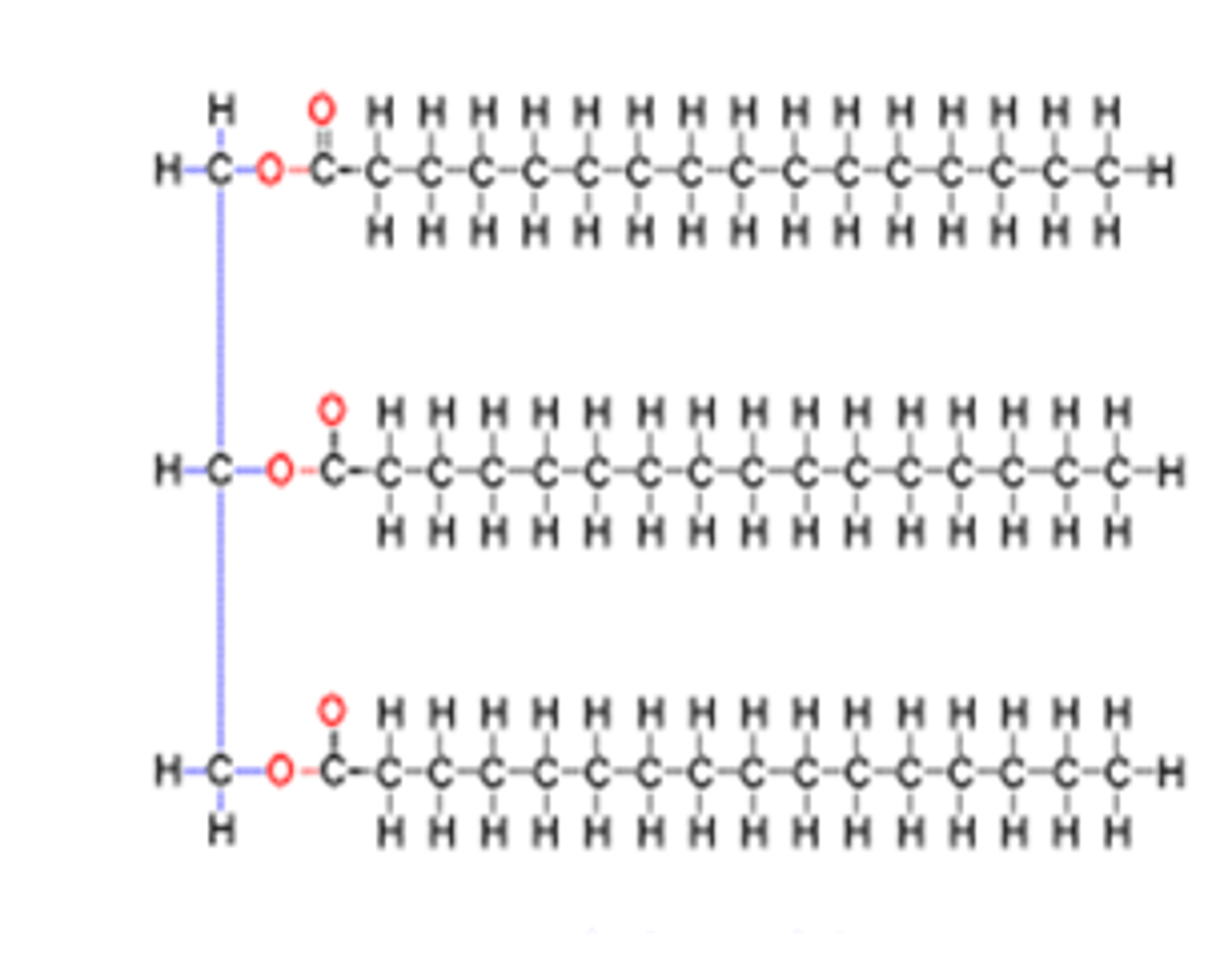
CRB Which of the following is NOT another type of dietary fat?
(A) Cholesterol
(B) Free fatty acids
(C) Glycerol
(D) Phospholipids
(C) Glycerol
Other types of dietary fat include Cholesterol, Cholesterol Esters, Phospholipids and Free Fatty Acids.
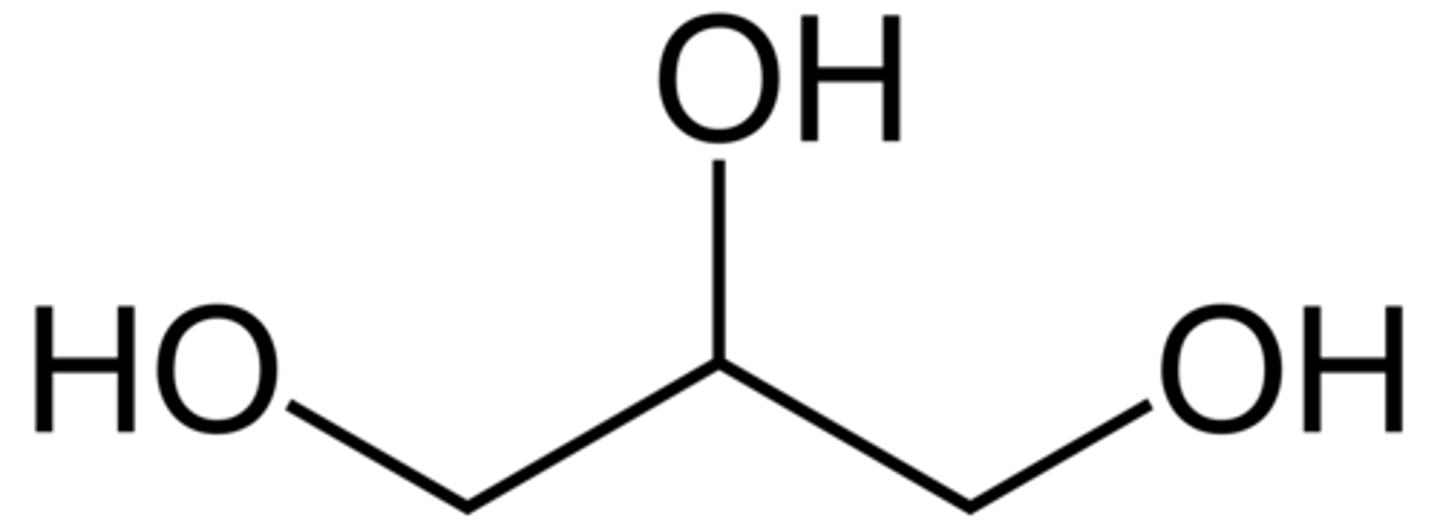
Compare saturated versus unsaturated fats.
Saturated fats are fully saturated with hydrogens, meaning that they do not have any double bonds.
Unsaturated fats have one or more double bonds.

Why is it more efficient to store energy as lipids rather than as glycogen?
First, the energy yield per gram of lipid (about 38 kJ/g) is more than twice that for carbohydrate
(about 17 kJ/g). Second, lipid is stored as anhydrous lipid droplets, but carbohydrates (such as glycogen and starch) are stored with water, which roughly triples the effective weight of carbohydrates.
Another reason that triacylglycerides are a great way for the body to store its energy is due to the fact that fats don't have a functional role in the body whereas proteins do. What does this mean?
Proteins make up the muscles in our bodies and perform vital functions as enzymes and transport proteins. If we primarily relied on muscles for our energy, we'd waste away and be unable to move. Most fats, on the other hand, don't have such a vital functional role.
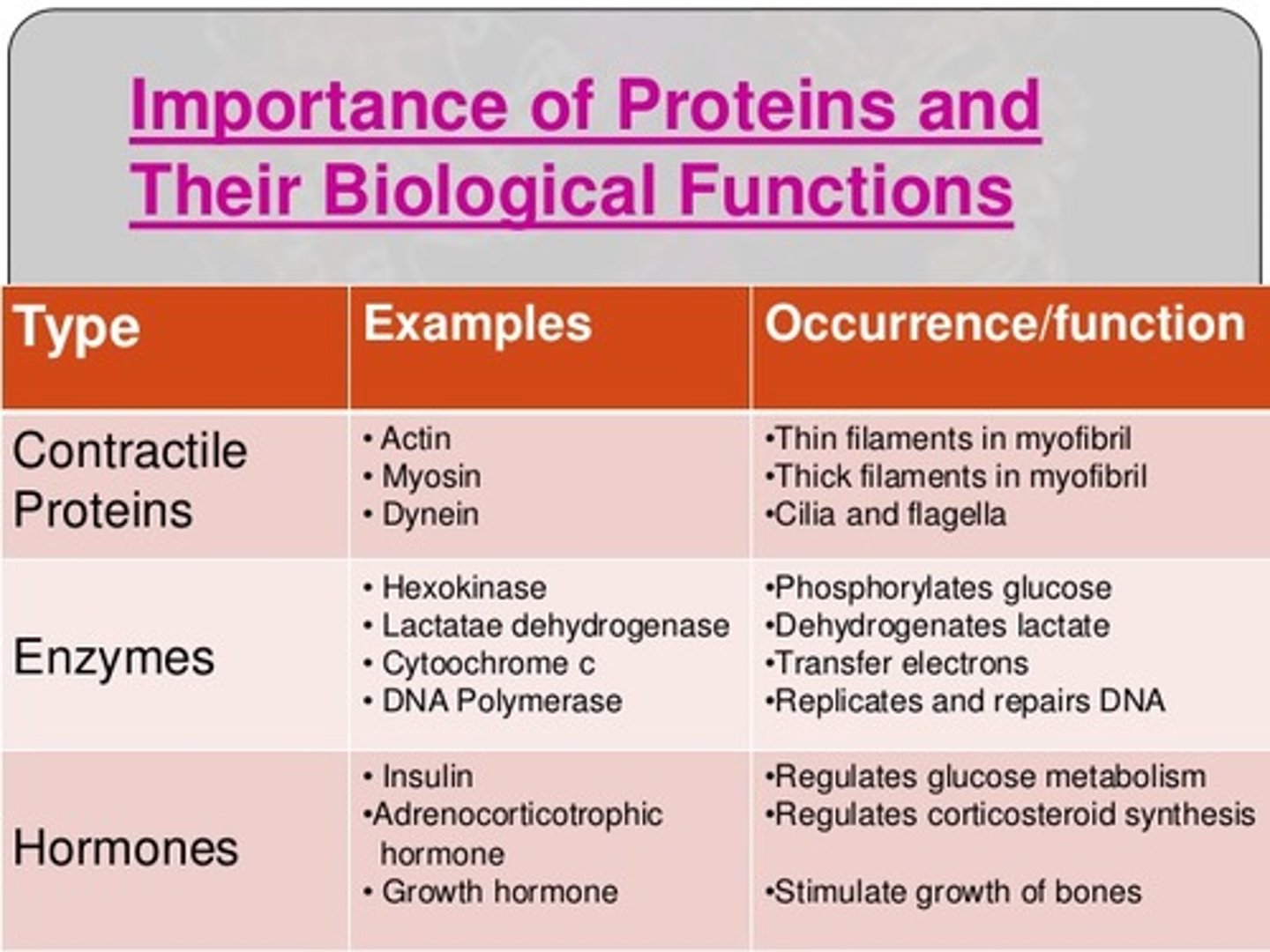
One reason that triacylglycerides are a great way for the body to store its energy is due to the fact that these molecules are relatively inert compared to sugars and protein. What does this mean?
This means that triacylglycerides are unlikely to react with other substances in the body.
What would happen to the body's ability to digest fats if the gall bladder stopped secreting bile into the small intestine?
Bile causes fats to be broken down into smaller chunks that are able to be digested and absorbed. Without bile, fat droplets would pass through without being absorbed, resulting in fatty diarrhea (stetorrhea).
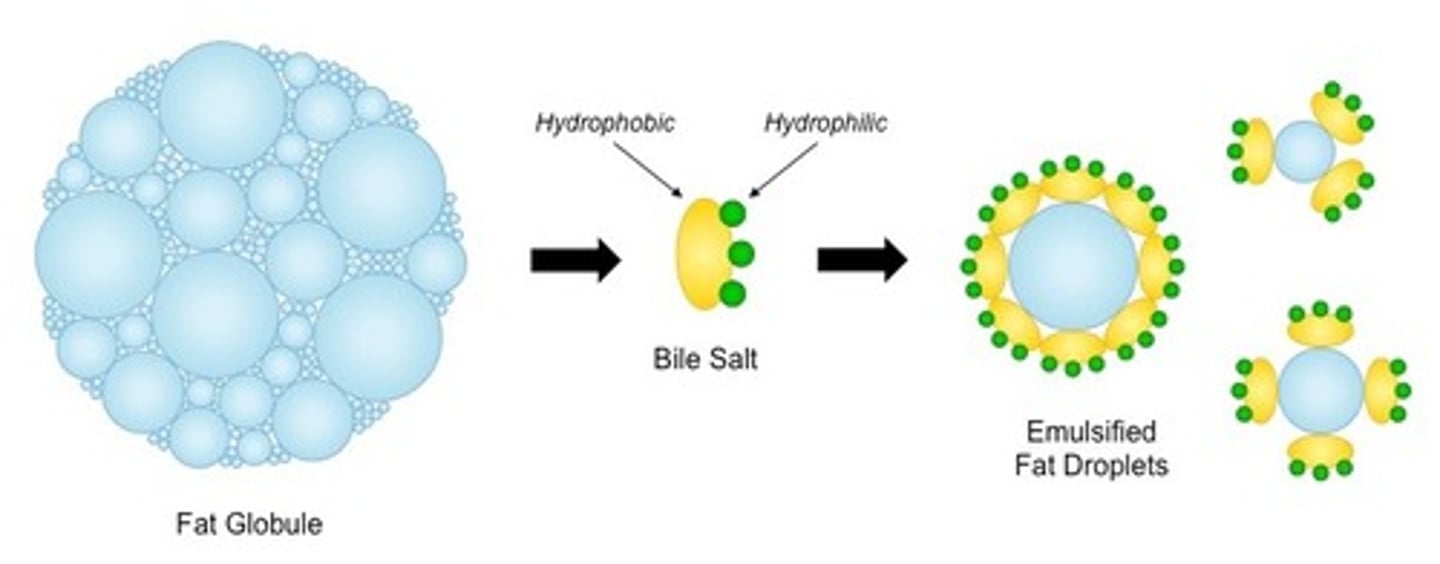
Bile emulsifies fats. Explain what this means on a chemical level.
Fats are very non-polar, making them avoid interaction with the water in our intestines. Instead, fats will clump together. Bile is both polar and nonpolar; thus, its nonpolar regions will interact with the fats and its polar regions will interact with the water, causing the fats to be dissolved.
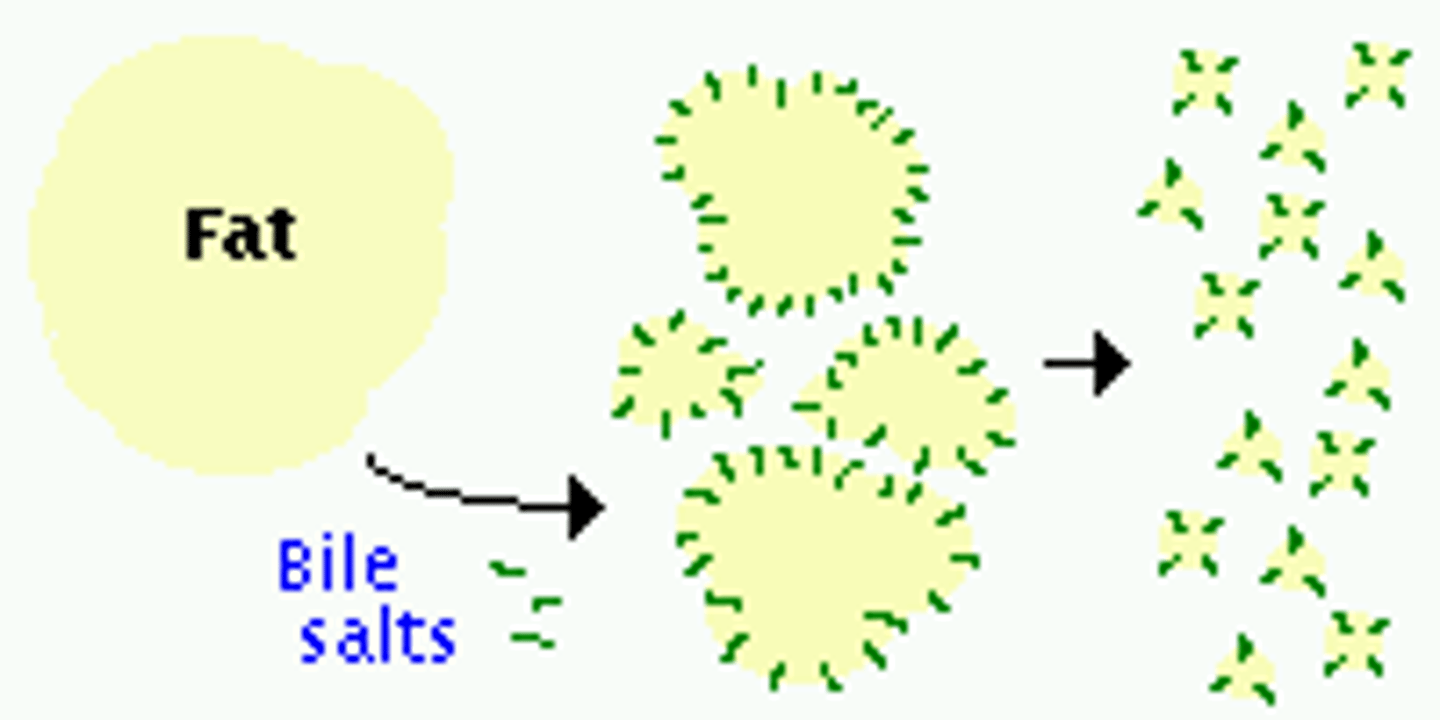
CRB Which of the following does bile NOT contain?
(A) Lipase
(B) Bile salts
(C) Pigments
(D) Cholesterol
(A) Lipase
Bile contains Bile Salts, Pigments and Cholesterol.
The pancreas can secrete lipases.

Draw or envision the reaction that takes place as a lipase enzyme acts on a triacylglycerol molecule.

Put the following steps of triacylglycerol digestion in order:
I. Triacylglycerol formation
II. Transport through lymphatic system
III. Transport into enterocyte
IV. Packaging
V. Triacylglycerol breakdown
VI. Transport through blood stream
(A) V > III > I > IV > II > VI
(B) I > III > V > IV > II > VI
(C) V > III > I > IV > VI > II
(D) I > III > V > IV > VI > II
(A) V > III > I > IV > II > VI
The following are the steps of triacylglycerol digestion in order:
V. Triacylglycerol breakdown
III. Transport into enterocyte
I. Triacylglycerol formation
IV. Packaging
II. Transport through lymphatic system
VI. Transport through blood stream
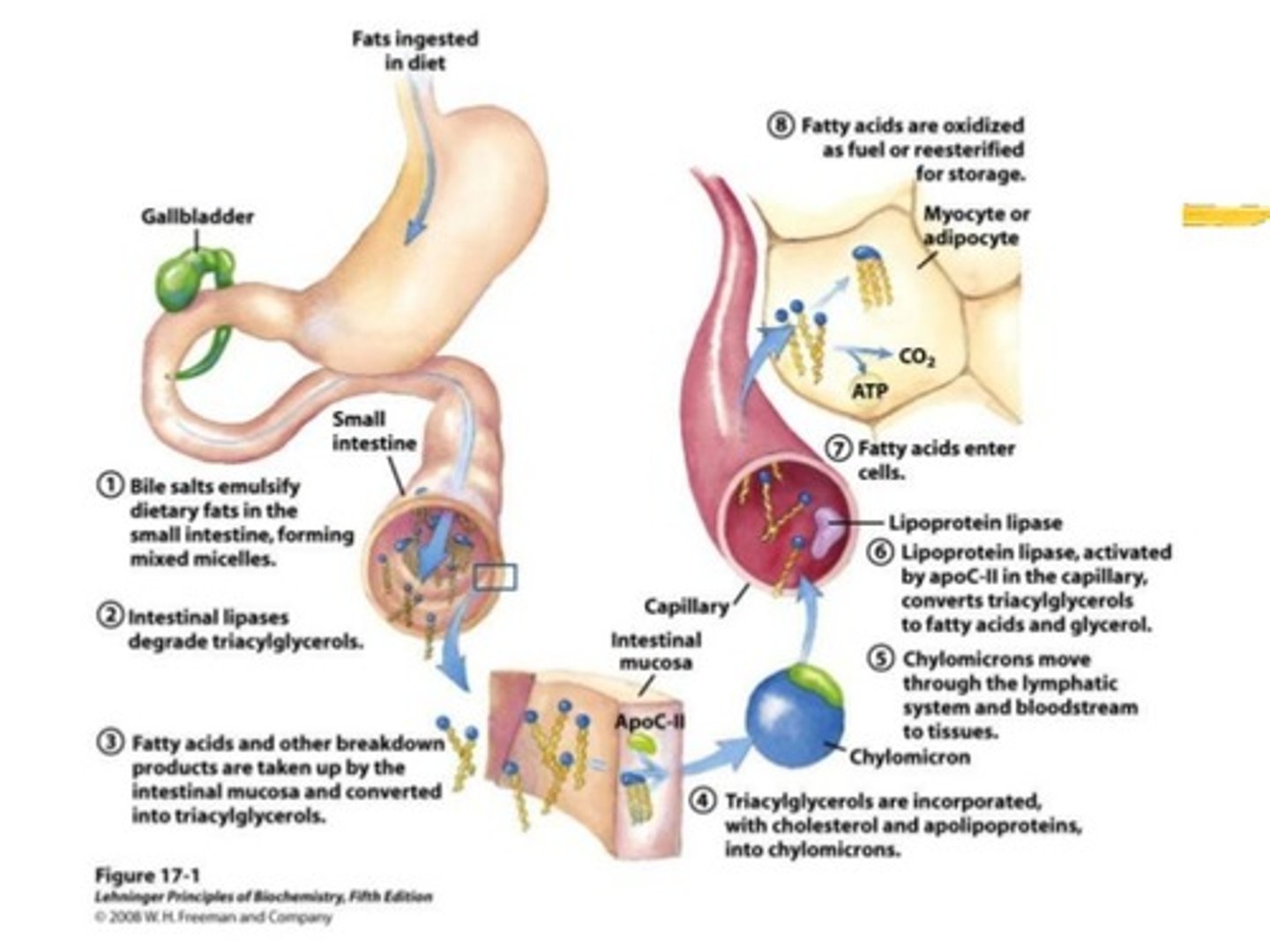
CRB True or false? When being transported into the Enterocyte (intestinal epithelium), the Free fatty acids, cholesterol, and bile salts are in Micelle form.
True. When being transported into the Enterocyte (intestinal epithelium), the Free fatty acids, cholesterol, and bile salts are in Micelle form.

Before being transported into the lymphatic system from the enterocyte (intestinal cell), triacylglycerides are packaged into chylomicrons. Describe the structure of a chylomicron.
Chylomicrons consist of lipoproteins and fatty acids which form a bubble around triacylglycerides and other fats.
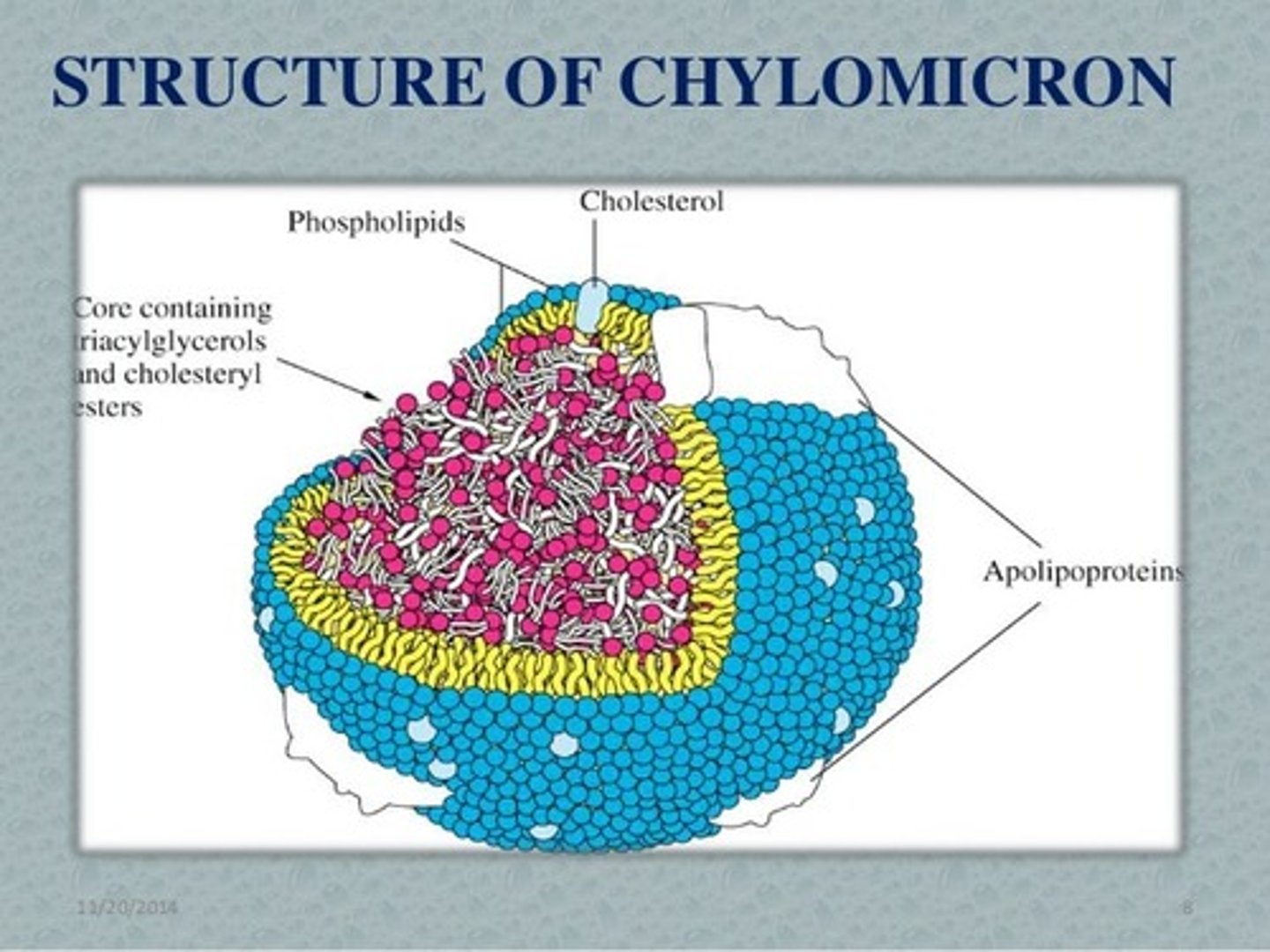
When chylomicrons first enter the lymphatic system, they enter via small lymphatic capillaries known as:
(A) chylolymphs
(B) enterolymphs
(C) chylopermeases
(D) lacteals
(D) lacteals
When chylomicrons first enter the lymphatic system, they enter via small lymphatic capillaries known as lacteals.

The chylomicrons will empty into the veins of the bloodstream via which of the following:
I. Right Thoracic Duct
II. Central Thoracic Duct
III. Left Thoracic Duct
(A) I Only
(B) I and II Only
(C) I and III Only
(D) II and III Only
(C) I and III Only
The chylomicrons will empty into the bloodstream via the right and left thoracic duct.
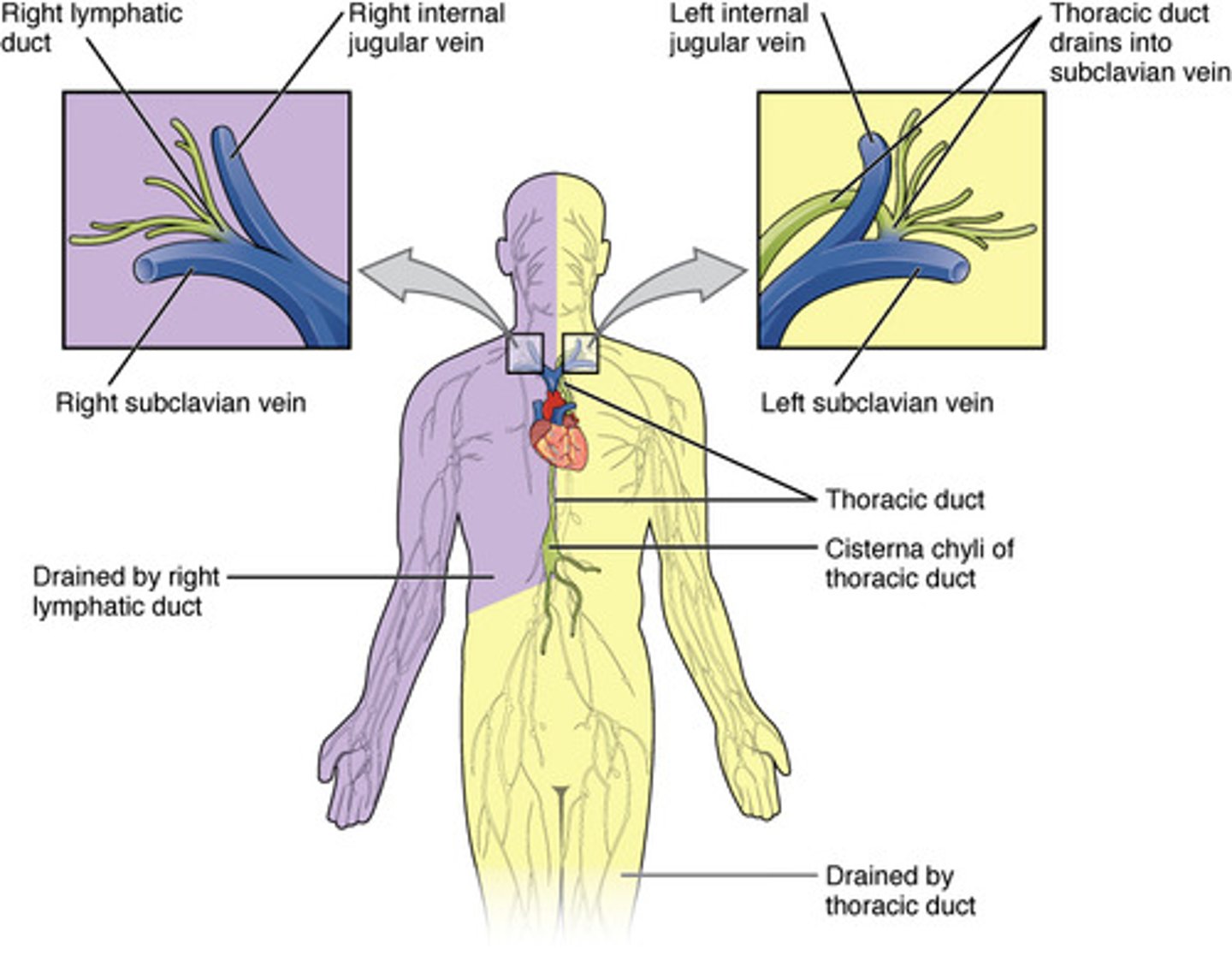
When the chylomicrons reach the capillaries, their triacylglycerol molecules will get broken down into fatty acids via lipoprotein lipase. Which of the following hormones activates lipoprotein lipase?
(A) Glucagon
(B) Estrogen
(C) Insulin
(D) Testosterone
(C) Insulin
Insulin is released when blood glucose levels are high, during the post-fed state. It promotes the storage of energy by activating lipoprotein lipase and activating glucose transporters. This allows these biomolecules to enter cells for storage.

True or False? After the fatty acids are absorbed by adipocytes, they are reconverted back into triacylglycerides.
True. After the fatty acids are absorbed by adipocytes, they are reconverted back into triacylglycerides.
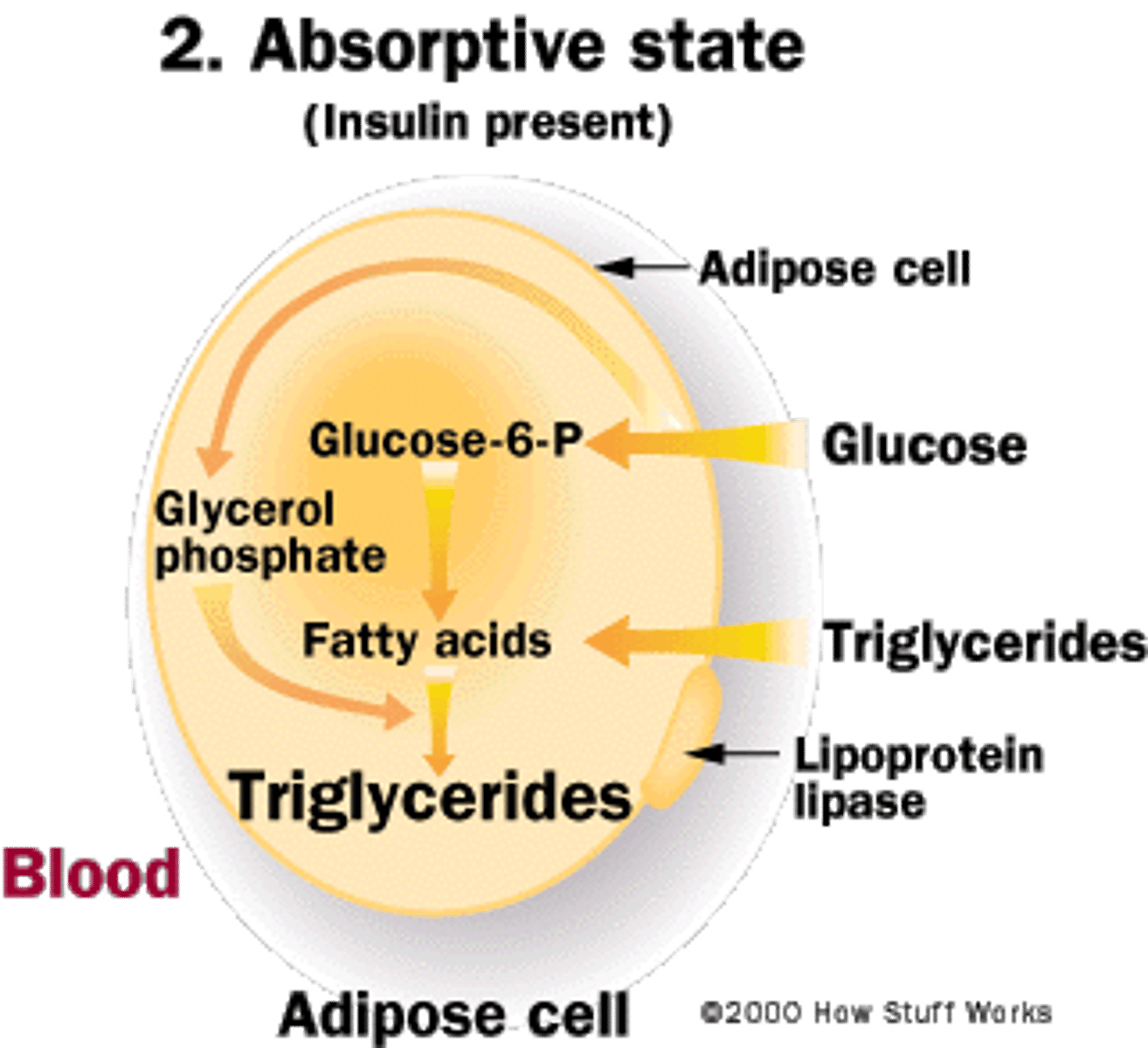
Why doesn't the body simply leave fats in the triacylgycerol form instead of interconverting between triacylglycerol and fatty acids all the time?
Triacylglycerol molecules are too large to diffuse through membranes and need to be broken down into fatty acids first.
It can be said that all digestion leads to the liver. Describe the path that each of the following macronutrients takes to get from the small intestine to the liver:
(1) Sugars
(2) Proteins
(3) Fats
(1) Sugars - sugars are broken down into mono- and disaccharides and are transported from enterocytes directly into capillaries that lead directly to the liver.
(2) Proteins - proteins are broken down into amino acids and are transported from enterocytes directly into capillaries that lead directly to the liver.
(3) Fats - as mentioned in the previous cards, they will be packaged into chylomicrons and then travel through the lymphatic system to the veins of the bloodstream. From there, they will enter arteries and finally capillaries where they will get broken down. The leftovers known as chylomicron remnants will then get transported to the liver.

Which of the following statements about fatty acid synthesis is correct?
(A) Fatty acids can be used to synthesize glucose.
(B) Fatty acids can be synthesized from glucose.
(C) Fatty acids can be broken down to generate NADPH
(D) Fatty acids are important in nucleotide synthesis.
(B) Fatty acids can be synthesized from glucose.
Excess glucose (from dietary carbohydrates) can be converted into acetyl-CoA, which can be used to build up fatty acids.
Because the PDH reaction is irreversible, fatty acids cannot be converted back into glucose.
Struggling to memorize the metabolic pathways (such as glycolysis and beta-oxidation)? Learn them like the back of your hand using Andrew's Metabolic Pathways Mastery Course @ https://mcatselfprep.com/course/andrews-metabolic-pathways-mastery-course/
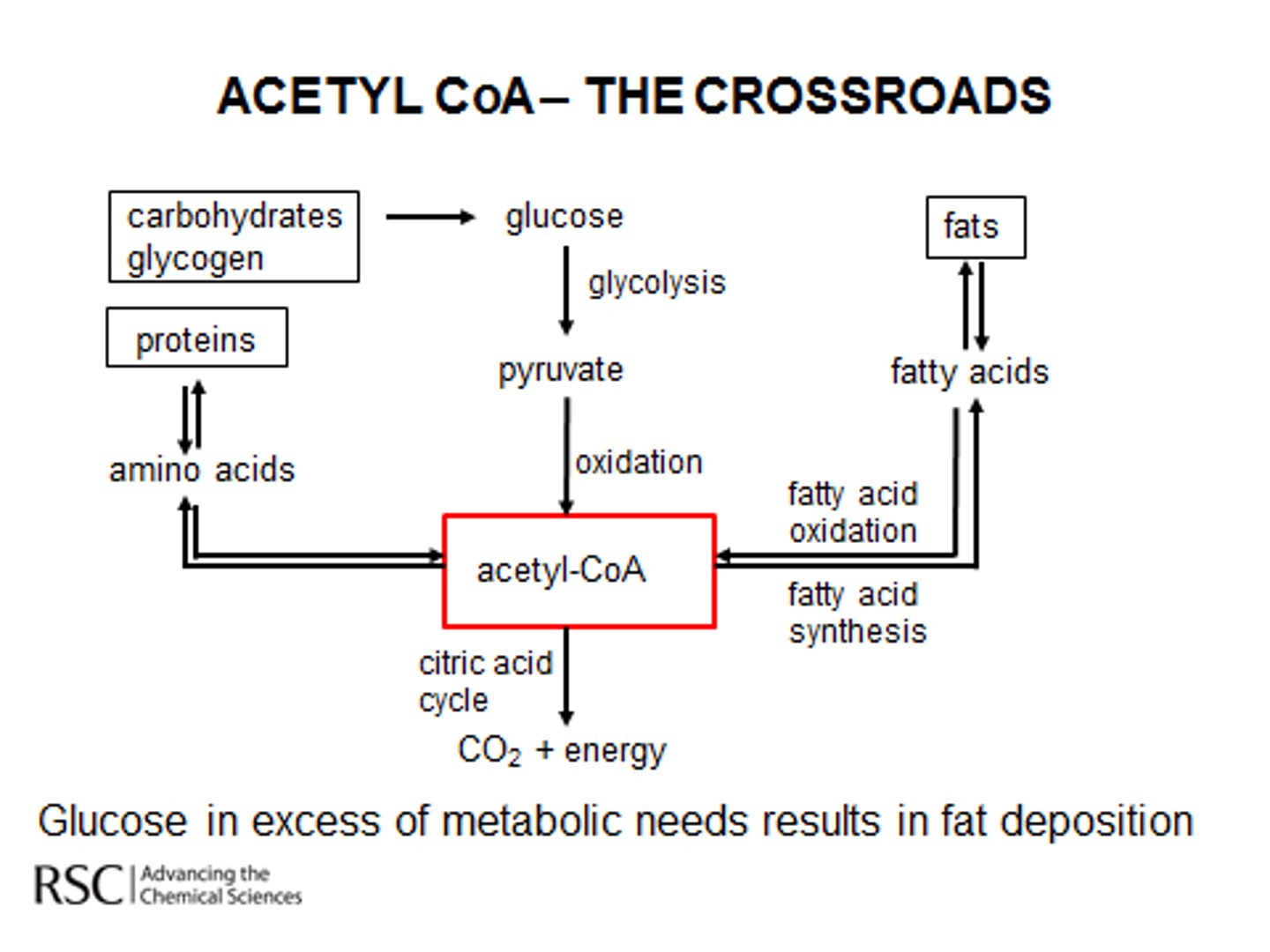
CRB Fatty Acid Synthesis is said to be Nontemplate Synthesis because it doesn't rely upon any Nucleic Acid coding. Which of the following are also Nontemplate Syntheses?
I. Nucleic Acid Synthesis
II. Protein Synthesis
III. Carbohydrate Synthesis
(A) III only
(B) I and II only
(C) II and III only
(D) I, II and III
(A) III only
Carbohydrate and Fatty Acid Synthesis are the nontemplate synthesis.
Protein and Nucleic Acid Syntheses are Template Syntheses.

In the liver, fatty acids synthesized from glucose can be packaged with the chylomicron remnants to form:
(A) HDLs
(B) Chylomicrons
(C) VLDLs
(D) Albumin
(C) VLDLs
In the liver, fatty acids synthesized from glucose can be packaged with the chylomicron remnants to form very low density lipoproteins (VLDLs).
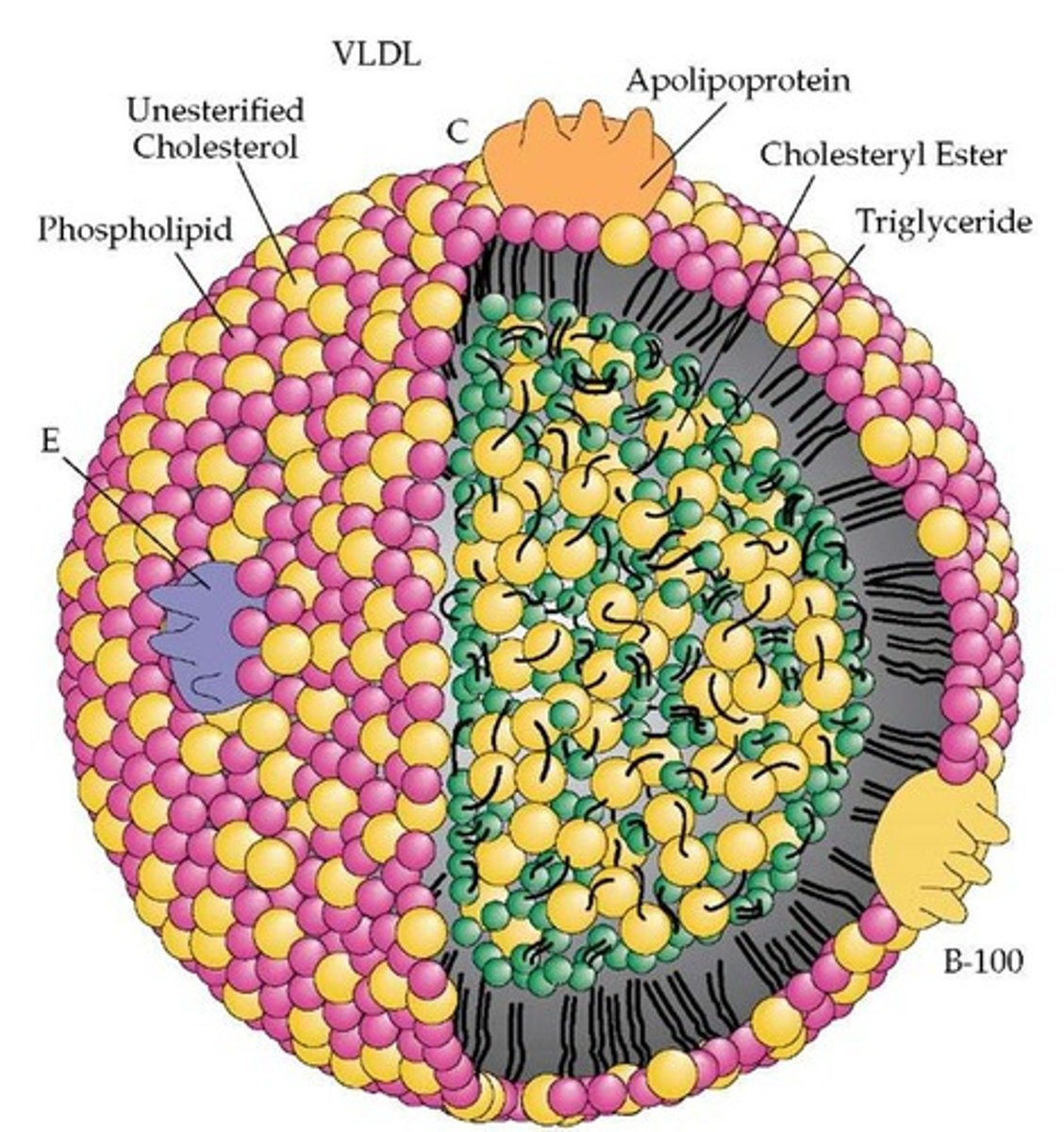
CRB VLDLs will transport the Triacylglycerols to various cells. What do you call the remains of the VLDL molecule?
(A) HDL
(B) LDL
(C) IDL
(D) MDL
(C) IDL
IDL (Intermediate Density Lipoprotein) is the remnants of VLDL, and is typically reabsorbed at the liver or used by the blood to become LDL.
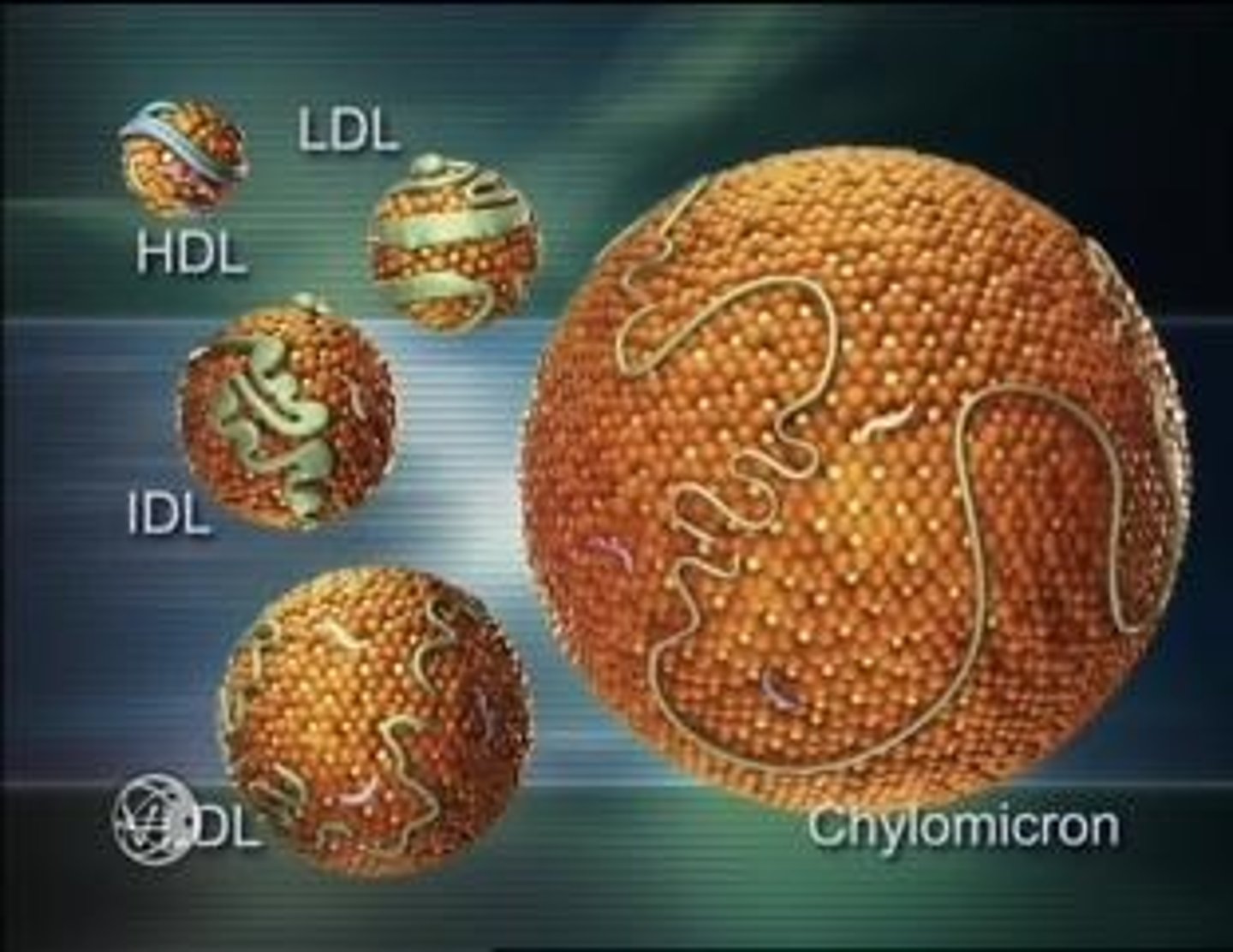
Compare the role of the following lipases:
(1) Bile salt-dependent lipase
(2) Lipoprotein lipase
(3) Hormone-sensitive lipase
(1) Bile salt-dependent lipase - Breaks down triacylglycerol molecules in the small intestine in preparation for absorption.
(2) Lipoprotein lipase - Breaks down triacylglycerol molecules in the bloodstream that are being transported by chylomicrons and VLDLs in preparation for absorption by adipocytes and other cells.
(3) Hormone-sensitive lipase - Breaks down triacylglycerol molecules in adipocytes in order to transport them into the bloodstream and to the rest of the body to use for energy.
Hormone-sensitive lipase will be activated by a decrease or increase in the concentration of insulin? Glucagon?
Hormone-sensitive lipase is activated during the fasting state due to decreasing levels of insulin and increasing levels of glucagon.
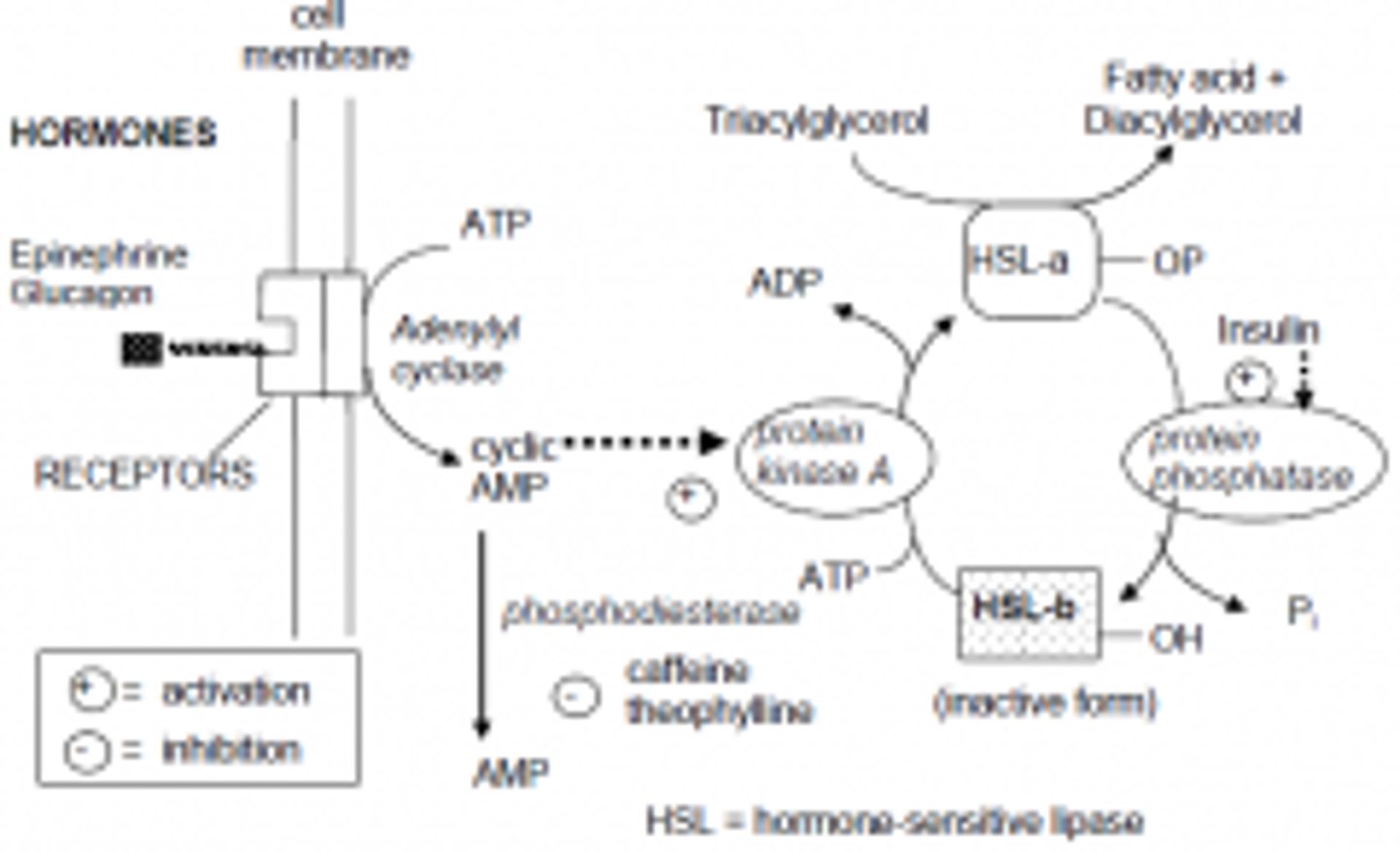
The fatty acids generated by hormone-sensitive lipase will travel through the bloodstream to their target tissues via:
(A) VLDLs
(B) HDLs
(C) Chylomicrons
(D) Albumin
(D) Albumin
The fatty acids generated by hormone-sensitive lipase will travel through the bloodstream to their target tissues via albumin
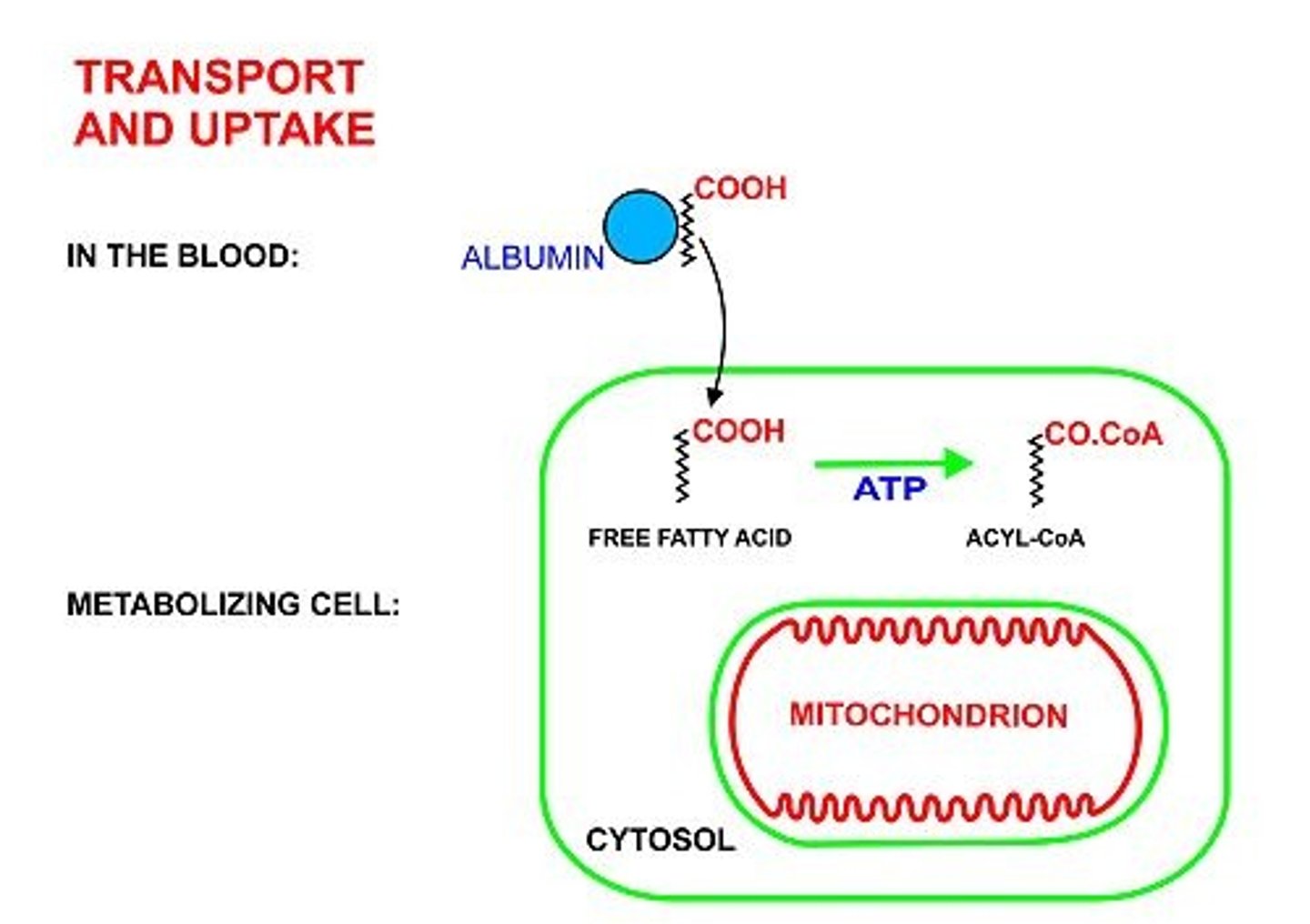
CRB Which of the following statements about LDL and HDL is FALSE?
(A) LDL and HDL are both mainly composed of cholesterol.
(B) HDL is associated with apolipoproteins that will recover excess cholesterol from the blood vessels.
(C) LDL is associated with most of the cholesterol measured in the blood, and delivers cholesterol to cells.
(D) None of the above statements are false.
(D) None of the above statements are false.
Each of the following statements is true:
(A) LDL and HDL are both mainly composed of cholesterol.
(B) HDL is associated with apolipoproteins that will recover excess cholesterol from the blood vessels.
(C) LDL is associated with most of the cholesterol measured in the blood, and delivers cholesterol to cells.
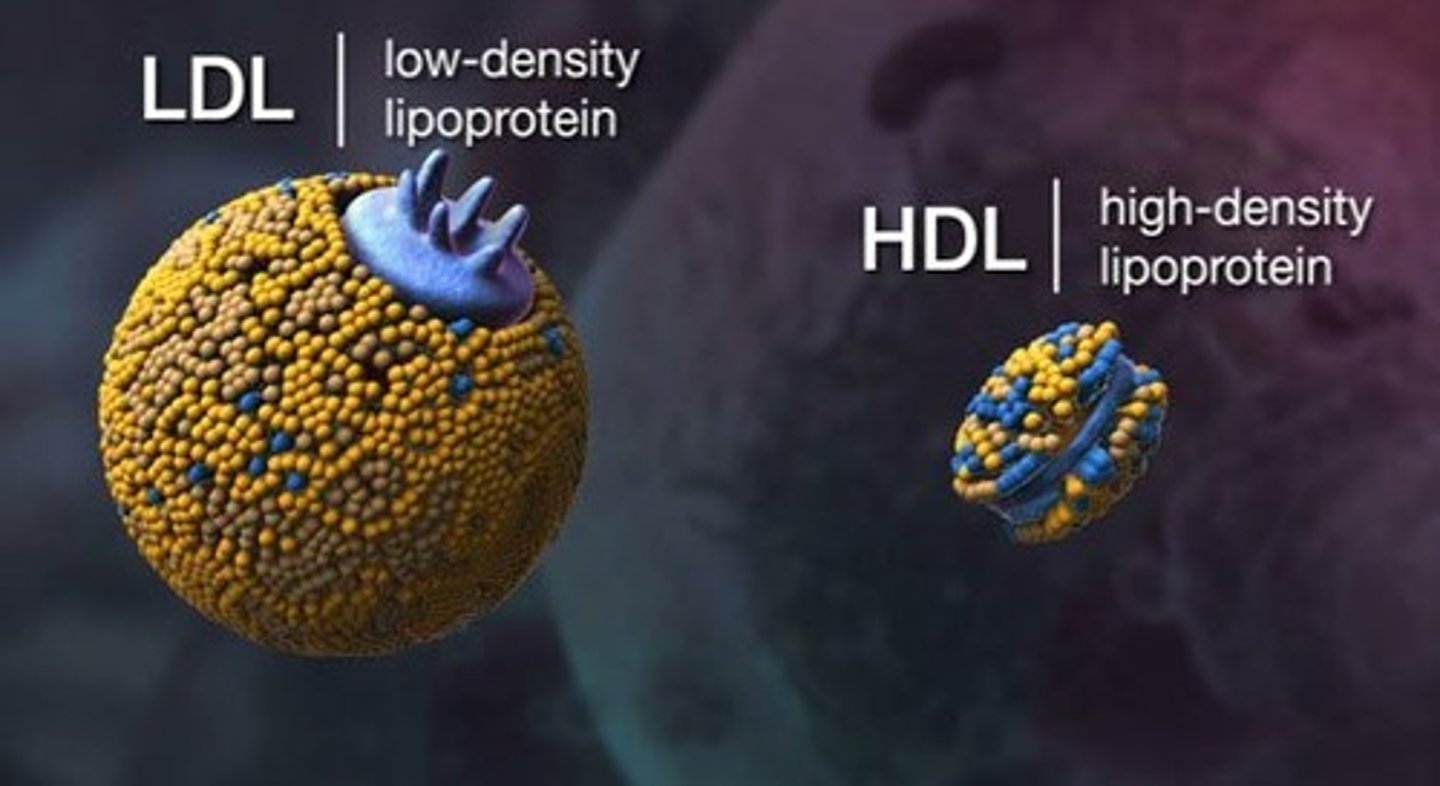
The liver will receive many of these fatty acids that are carried by albumin. Why does the liver need these fatty acids during the fasting state?
During the fasting state, the liver is working hard to produce glucose via the breakdown of glycogen. This requires energy, and the liver primarily relies on fatty acids for that energy.
Why doesn't the liver use its own glucose for energy or use its own glucose to make its own fatty acids?
During the fasting state, the liver's job is to generate glucose for the rest of the body. Thus, the liver will upregulate processes such as gluconeogenesis and glycogenolysis while downregulating processes such as fatty acid synthesis and glycolysis.
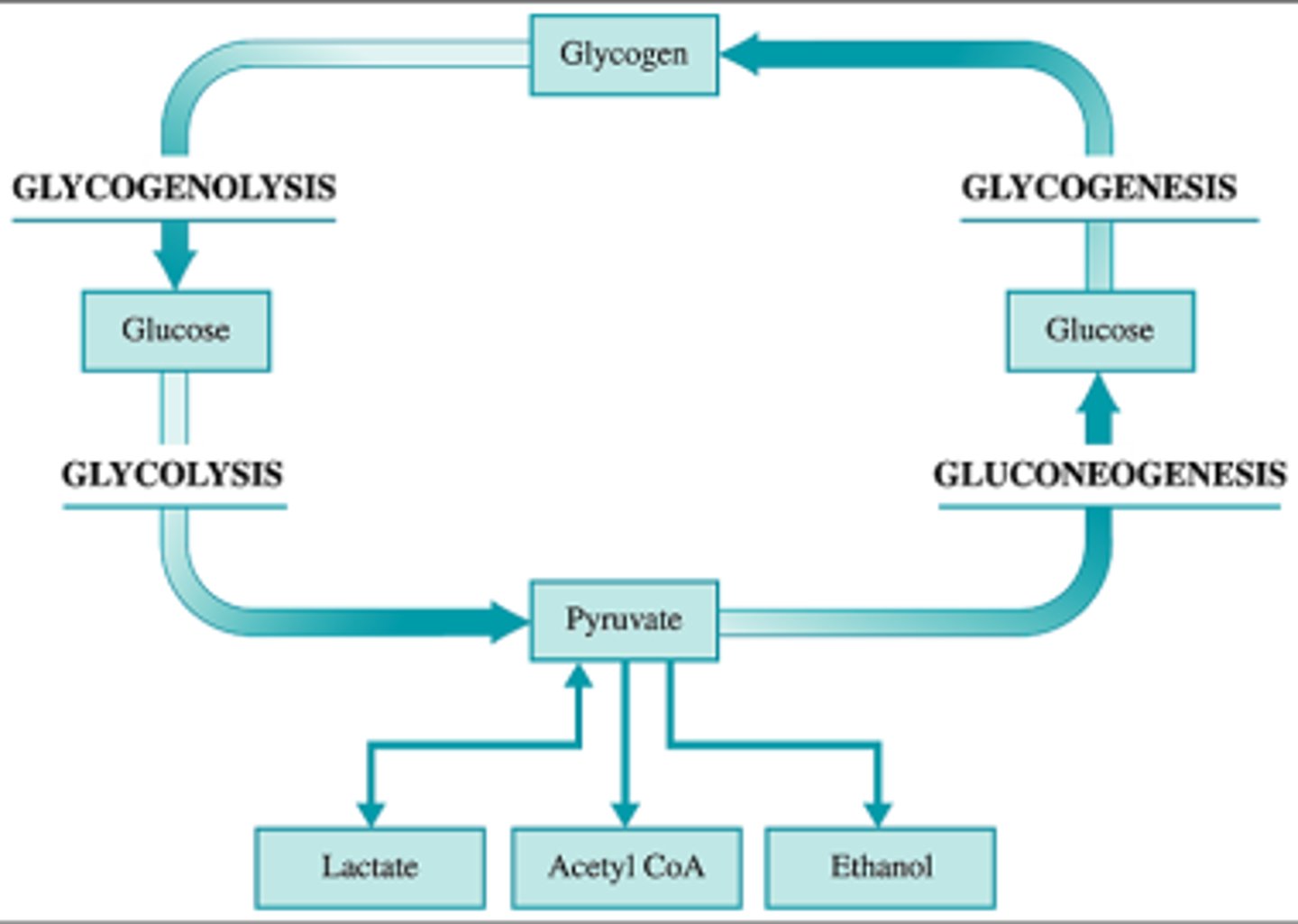
Where in the cell does fatty acid synthesis occur?
(A) Mitochondrial intermembrane space
(B) Mitochondrial Matrix
(C) Inner membrane of the mitochondria
(D) Cytoplasm
(D) Cytoplasm
Fatty acid synthesis occurs in the cytoplasm.
Struggling to memorize the metabolic pathways (such as glycolysis and beta-oxidation)? Learn them like the back of your hand using Andrew's Metabolic Pathways Mastery Course @ https://mcatselfprep.com/course/andrews-metabolic-pathways-mastery-course/

CRB What is the primary product of Fatty Acid Synthesis? Draw its structure.
Palmitate
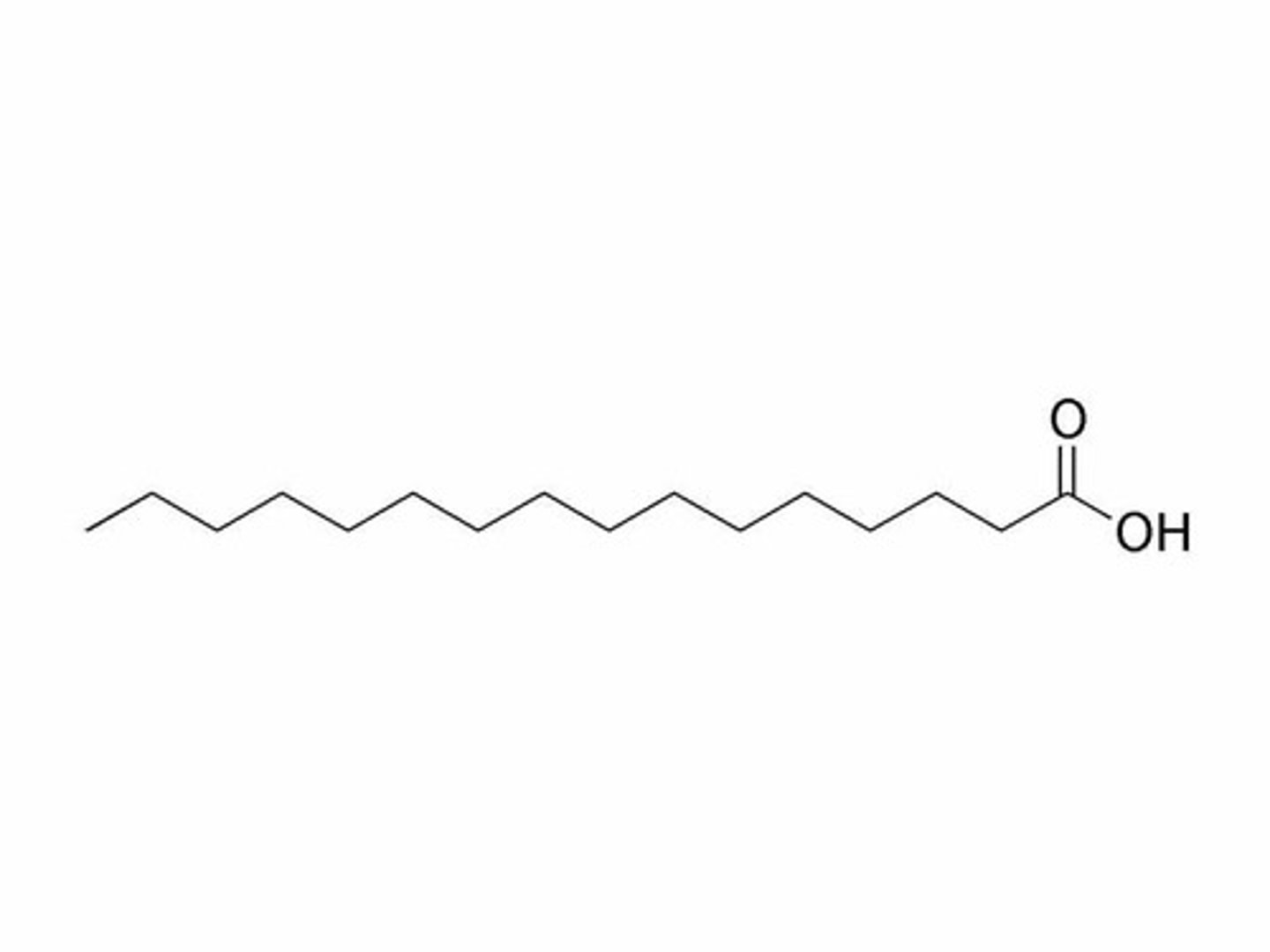
Because acetyl-CoA is the building block for fatty acid synthesis, we need to shuttle acetyl-CoA from the mitochondrial matrix into the cytoplasm. This is done via the:
(A) Malate Shuttle
(B) Citrate Shuttle
(C) Oxaloacetate Shuttle
(D) Acetyl-CoA Shuttle
(B) Citrate Shuttle
Because acetyl-CoA is the building block for fatty acid synthesis, we need to shuttle acetyl-CoA from the mitochondrial matrix into the cytoplasm. This is done via the citrate shuttle.
Struggling to memorize the metabolic pathways (such as glycolysis and beta-oxidation)? Learn them like the back of your hand using Andrew's Metabolic Pathways Mastery Course @ https://mcatselfprep.com/course/andrews-metabolic-pathways-mastery-course/
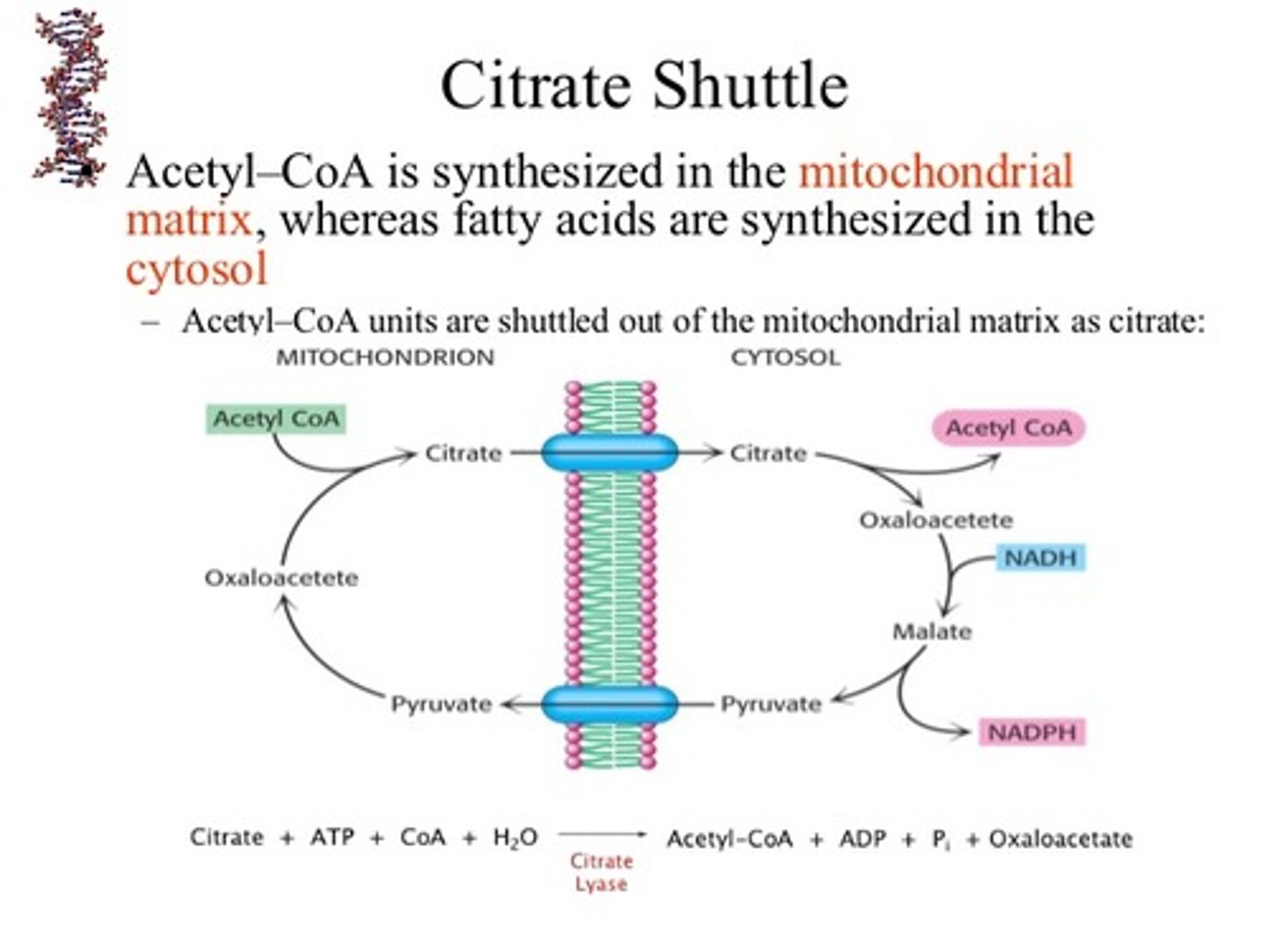
Draw the pathway for transporting acetyl-CoA into the cytoplasm for fatty acid synthesis (citrate shuttle), including all the enzymes, substrates, and energy substrates.
It is absolutely necessary to be able to do this for the MCAT. And because it is so challenging to memorize all of this point blank, we've created our Metabolic Pathways Mastery Course: https://mcatselfprep.com/course/andrews-metabolic-pathways-mastery-course/
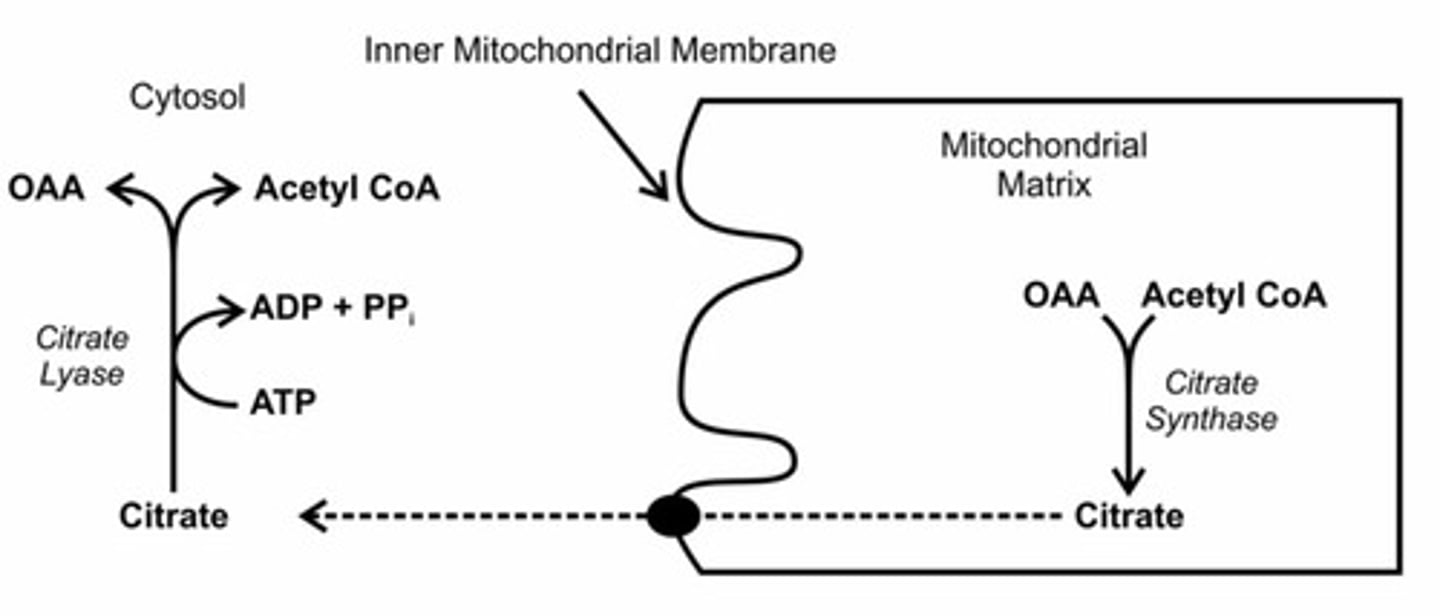
One way to get Oxaloacetate back into the mitochondria is to convert it into pyruvate, which produces a molecule of NADPH. Besides activating antioxidants, what other role does NADPH play within the cell?
NADPH is used as an important reducing agent during fatty acid synthesis.
Struggling to memorize the metabolic pathways (such as glycolysis and beta-oxidation)? Learn them like the back of your hand using Andrew's Metabolic Pathways Mastery Course @ https://mcatselfprep.com/course/andrews-metabolic-pathways-mastery-course/

If a 20-carbon long fatty acid is synthesized from 10 acetyl-CoA molecules, ___ ATP and ___ NADPH will be required.
(A) 10, 10
(B) 10, 20
(C) 9, 9
(D) 9, 18
(D) 9, 18
If a 20-carbon long fatty acid is synthesized from 10 acetyl-CoA molecules, 9 ATP and 18 NADPH will be required.
Struggling to memorize the metabolic pathways (such as glycolysis and beta-oxidation)? Learn them like the back of your hand using Andrew's Metabolic Pathways Mastery Course @ https://mcatselfprep.com/course/andrews-metabolic-pathways-mastery-course/
Draw out the fatty acid synthesis pathway, including all enzymes, substrates, and energy substrates.
It is absolutely necessary to be able to do this for the MCAT. And because it is so challenging to memorize all of this point blank, we've created our Metabolic Pathways Mastery Course: https://mcatselfprep.com/course/andrews-metabolic-pathways-mastery-course/

Which enzyme in the fatty acid synthesis pathway catalyzes the rate-limiting step?
(A) Fatty Acid Synthase
(B) Acetyl-CoA Carboxylase
(C) Citrate Lyase
(D) Citrate Synthase
(B) Acetyl-CoA Carboxylase
Acetyl-CoA carboxylase is the enzyme that catalyzes the rate-limiting step of fatty acid synthesis.
Struggling to memorize the metabolic pathways (such as glycolysis and beta-oxidation)? Learn them like the back of your hand using Andrew's Metabolic Pathways Mastery Course @ https://mcatselfprep.com/course/andrews-metabolic-pathways-mastery-course/
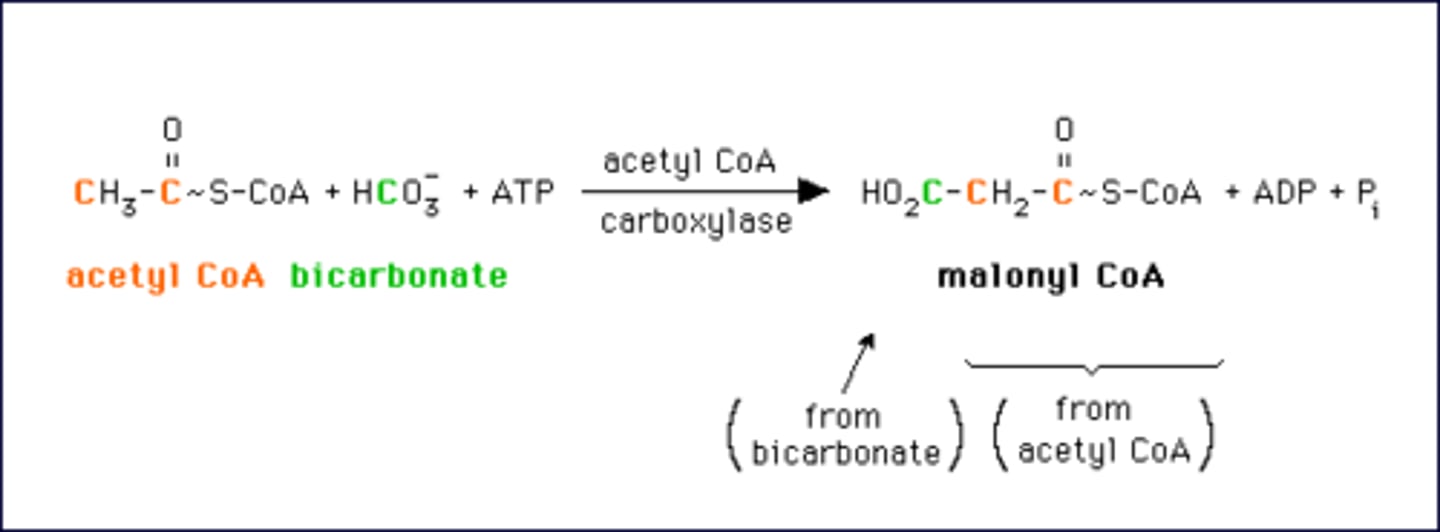
Will it activate or inhibit acetyl-CoA carboxylase?
(1) Citrate
(2) Glucagon
(3) Fatty Acids
(4) Insulin
(1) Citrate - activate
(2) Glucagon - inhibit
(3) Fatty Acids - inhibit
(4) Insulin - activate
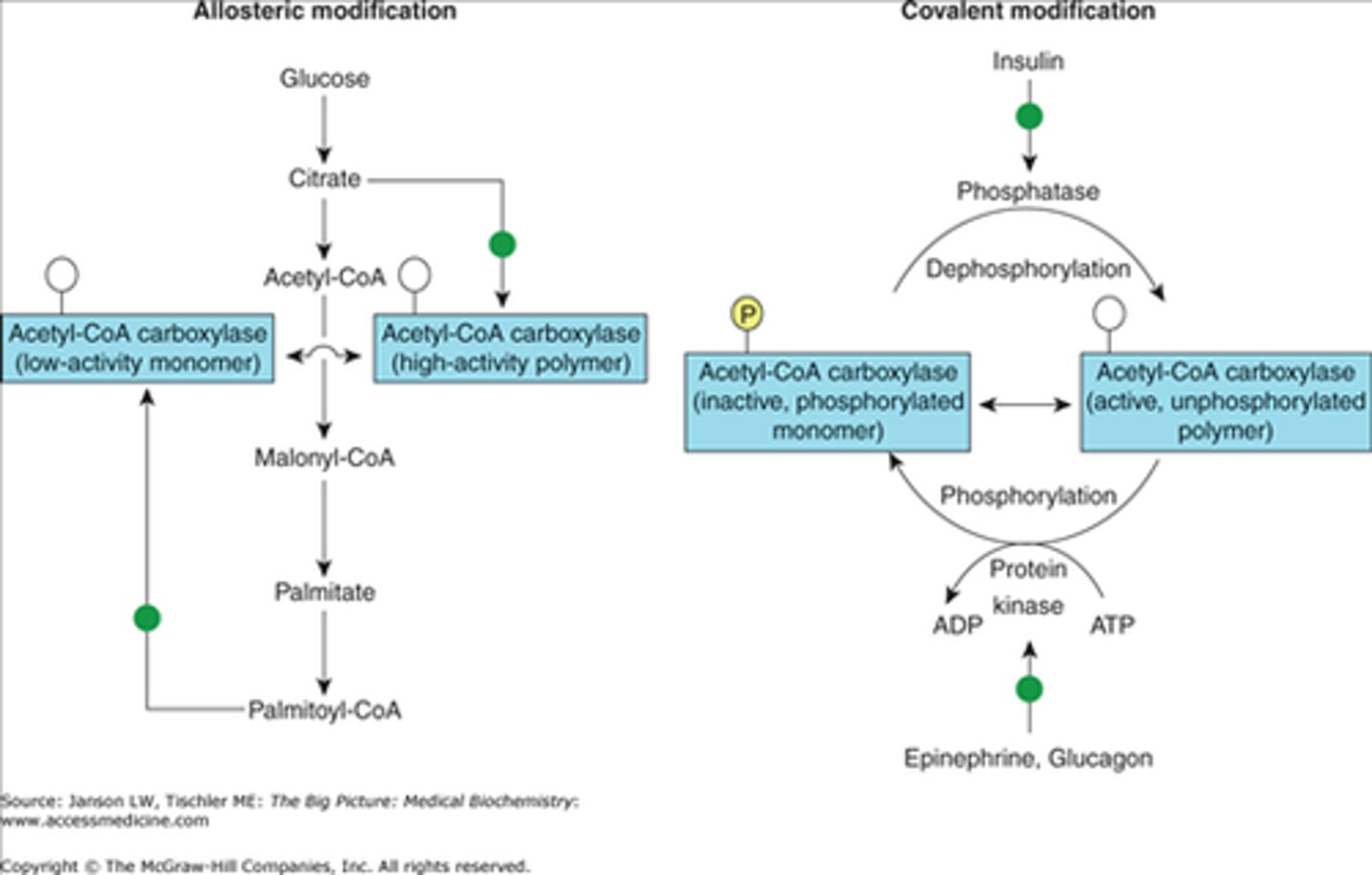
CRB Which of the following are required for Acetyl-CoA Carboxylase to function?
I. ATP
II. Biotin
III. NADH
(A) III only
(B) I and II only
(C) I and III only
(D) I, II and III
(B) I and II only
ATP and Biotin are required for Acetyl-CoA Carboxylase to function.

What two substrates intially bind to fatty acid synthase during the polymerization of a long-chain fatty acid?
Acetyl-CoA and malonyl-CoA
Struggling to memorize the metabolic pathways (such as glycolysis and beta-oxidation)? Learn them like the back of your hand using Andrew's Metabolic Pathways Mastery Course @ https://mcatselfprep.com/course/andrews-metabolic-pathways-mastery-course/

In the first step of fatty acid synthesis, a carbon dioxide molecule is added to acetyl-CoA and later on it is removed. Why add a CO2 just to remove it again?
Adding a CO2 to acetyl-CoA allows an unfavorable reaction to be favorable. In particular, when the CO2 group is removed, it causes electrons to be placed on one of the carbons of malonyl-CoA, which can then attack the acetyl-CoA, resulting in polymerization.

After the reaction between the acetyl-CoA and malonyl-CoA on fatty acid synthase, a 4-carbon long fatty acid is left bound to fatty acid synthase. What substrate will come along next and bind to fatty acid synthase, allowing the polymerization reaction to continue?
Malonyl-CoA
Struggling to memorize the metabolic pathways (such as glycolysis and beta-oxidation)? Learn them like the back of your hand using Andrew's Metabolic Pathways Mastery Course @ https://mcatselfprep.com/course/andrews-metabolic-pathways-mastery-course/

CRB True or false? The product of Acetyl-CoA Carboxylase is the Malonyl-CoA that will be used in Fatty Acid Synthesis.
True. The product of Acetyl-CoA Carboxylase is the Malonyl-CoA that will be used in Fatty Acid Synthesis.
Struggling to memorize the metabolic pathways (such as glycolysis and beta-oxidation)? Learn them like the back of your hand using Andrew's Metabolic Pathways Mastery Course @ https://mcatselfprep.com/course/andrews-metabolic-pathways-mastery-course/
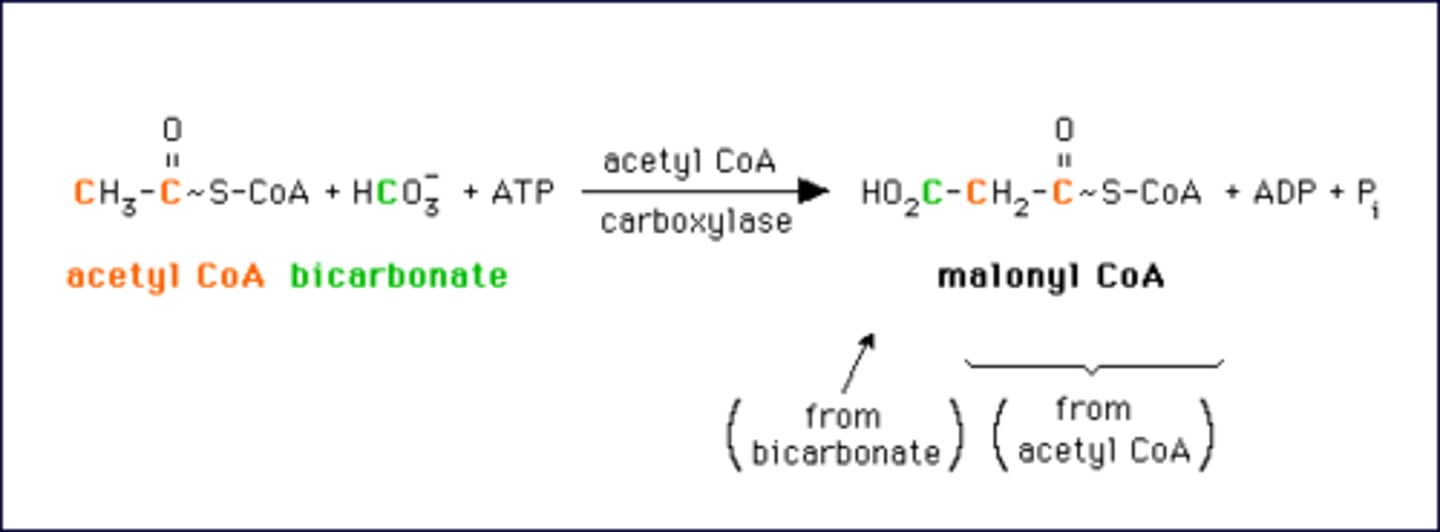
CRB Where could Palmitate be elongated or desaturated to form other fatty acids?
(A) Rough ER
(B) Smooth ER
(C) Golgi
(D) Mitochondria
(B) Smooth ER
In the Smooth ER, fatty acids could be elongated or desaturated.
